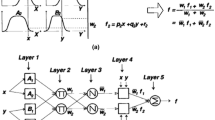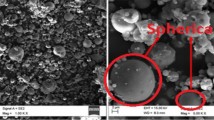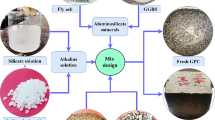Abstract
In the present work, compressive strength of geopolymers made from seeded fly ash and rice husk–bark ash has been predicted by adaptive network-based fuzzy inference systems (ANFIS). Different specimens, made from a mixture of fly ash and rice husk–bark ash in fine and coarse forms and a mixture of water glass and NaOH mixture as alkali activator, were subjected to compressive strength tests at 7 and 28 days of curing. The curing regimes were different: one set of the specimens were cured in water at room temperature until 7 and 28 days and the other sets were oven-cured for 36 h at the range of 40–90°C and then cured at room temperature until 7 and 28 days. A model based on ANFIS for predicting the compressive strength of the specimens has been presented. To build the model, training and testing using experimental results from 120 specimens were conducted. The used data as the inputs of ANFIS models are arranged in a format of six parameters that cover the percentage of fine fly ash in the ashes mixture, the percentage of coarse fly ash in the ashes mixture, the percentage of fine rice husk–bark ash in the ashes mixture, the percentage of coarse rice husk–bark ash in the ashes mixture, the temperature of curing, and the time of water curing. According to these input parameters in the ANFIS models, the compressive strength of each specimen was predicted. The training and testing results in ANFIS models showed a strong potential for predicting the compressive strength of the geopolymeric specimens.










Similar content being viewed by others
Change history
02 May 2020
Additionally, the article shows evidence of peer review manipulation and authorship manipulation.
References
Wongpa J, Kiattikomol K, Jaturapitakkul C, Chindaprasirt P (2010) Compressive strength, modulus of elasticity, and water permeability of inorganic polymer concrete, mater. Design 31:4748–4754
Davidovits J (1991) Geopolymers: inorganic polymeric new materials. J Therm Anal 37:1633–1656
van Jaarsveld JGS, van Deventer JSJ, Lorenzen L (1997) The potential use of geopolymeric materials to immobilise toxic metals. Part I. Theory and applications. Miner Eng 10:659–669
Álvarez-Ayuso E, Querol X, Plan F, Alastuey A, Moreno N, Izquierdo M, Font O, Moreno T, Diez S, Vázquez E, Barra M (2008) Environmental, physical and structural characterisation of geopolymer matrixes synthesised from coal (co-)combustion fly ashes. J Hazardous Mater 154:175–183
Sata V, Jaturapitakkul C, Kiattikomol K (2007) Influence of pozzolan from various byproduct materials on mechanical properties of high-strength concrete. Constr Build Mater 21(7):1589–1598
Tangchirapat W, Buranasing R, Jaturapitakkul C, Chindaprasirt P (2008) Influence of rice husk–bark ash on mechanical properties of concrete containing high amount of recycled aggregates. Constr Build Mater 22(8):1812–1819
Nazari A, Riahi S (2010) Computer-aided prediction of physical and mechanical properties of high strength cementitious composite containing Cr2O3 nanoparticles. Nanotechnology 5(5):301–318
Nazari A, Riahi S (2011) Prediction split tensile strength and water permeability of high strength concrete containing TiO2 nanoparticles by artificial neural network and genetic programming. Com Part B Eng 42:473–488
Nazari A, Riahi S (2011) Computer-aided design of the effects of Fe2O3 nanoparticles on split tensile strength and water permeability of high strength concrete. Mater Des 32:3966–3979
Nazari A, Milani AA, Zakeri M (2011) Modeling ductile to brittle transition temperature of functionally graded steels by artificial neural networks. Comput Mater Sci 50:2028–2037
Nazari A, Milani AA (2011) Modeling ductile to brittle transition temperature of functionally graded steels by fuzzy logic. J Mat Sci 46(18):6007–6017
Nazari A, Didehvar N (2011) Modeling impact resistance of aluminum-epoxy laminated composites by ANFIS. doi:10.1016/j.compositesb.2011.05.043
Jang JSR (1993) ANFIS: adaptive-network-based fuzzy inference system. IEEE Trans Syst Man Cyber 23(3):665–685
Sarıdemir M (2009) Predicting the compressive strength of mortars containing metakaolin by artificial neural networks and fuzzy logic. Adv Eng Soft 40(9):920–927
Pacheco-Togal F, Castro-Gomes J, Jalali S (2007) Investigation about the effect of aggregates on strength and microstructure of geopolymeric mine waste mud binders. Cem Concr Res 37(6):933–941
Pacheco-Torgal F, Castro-Gomes JP, Jalali S (2005) Studies about mix composition of alkali-activated mortars using waste mud from Panasqueira. In: Proceedings of the engineering conference. University of Beira Interior, Covilha, Portugal
Bakharev T (2005) Geopolymeric materials prepared using class F fly ash and elevated temperature curing. Cement Concrete Res 35:1224–1232
Chindaprasirt P, Chareerat T, Sirivivatnanon V (2007) Workability and strength of coarse high calcium fly ash geopolymer. Cement Concrete Comp 29:224–229
Zuhua Z, Xiao Y, Huajun Z, Yue C (2009) Role of water in the synthesis of calcined kaolin-based geopolymer. Appl Clay Sci 43(2):218–223
Fernandez-Jimenez A, Garcia-Lodeiro I, Palomo A (2007) Durability of alkali-activated fly ash cementitious materials. J Mater Sci 42(9):3055–3065
Van Jaarsveld JGS, Van Deventer JSJ, Lukey GC (2002) The effect of composition and temperature on the properties of fly ash–and kaolinite-based geopolymers. Chem Eng J 89(1–3):63–73
Naji Givi A, Abdul Rashid S, Nora A, Aziz F, Mohd Salleh MA (2010) Assessment of the effects of rice husk ash particle size on strength, water permeability and workability of binary blended concrete. Const Build Mat 24(11):2145–2150
Zholobenko VL, Holmes SM, Cundy CS, Dwyer J (1997) Microporous Mater 11:83
Ramezanianpour AA, Sobhani M, Sobhani J (2004) Application of network based neuro-fuzzy system for prediction of the strength of high strength concrete. Amirkabir J Sci Technol 5(59-C):78–93
Ramezanianpour AA, Sobhani J, Sobhani M (2004) Application of an adaptive neurofuzzy system in the prediction of HPC compressive strength. In: Proceedings of the fourth international conference on engineering computational technology. Civil-Comp Press, Lisbon, Portugal, p 138
Topcu IB, Sarıdemir M (2008) Prediction of mechanical properties of recycled aggregate concretes containing silica fume using artificial neural networks and fuzzy logic. Comp Mater Sci 42(1):74–82
Jang JSR, Sun CT (1995) Nuro-fuzzy modeling and control. Proc IEEE 83:3
Guzelbey IH, Cevik A, Erklig A (2006) Prediction of web crippling strength of cold-formed steel sheeting’s using neural networks. J Constr Steel Res 62:962–973
Guzelbey IH, Cevik A, Gögüs MT (2006) Prediction of rotation capacity of wide flange beams using neural networks. J Constr Steel Res 62:950–961
Cevik A, Guzelbey IH (2008) Neural Network modeling of strength enhancement for Cfrp confined concrete cylinders. Build Environ 43:751–763
Cevik A. Guzelbey IH (2007) A soft computing based approach for the prediction of ultimate strength of metal plates in compression. Eng Struct 29(3):383–394
Topcu IB, Sarıdemir M (2008) Prediction of compressive strength of concrete containing fly ash using artificial neural network and fuzzy logic. Comp Mater Sci 41(3):305–311
Author information
Authors and Affiliations
Corresponding author
Additional information
The Editor-in-Chief has retracted this article because it significantly overlaps with a number of articles including those that were under consideration at the same time and previously published articles. Additionally, the article shows evidence of peer review manipulation and authorship manipulation. The authors have not responded to any correspondence regarding this retraction.
About this article
Cite this article
Nazari, A., Khalaj, G. & Riahi, S. RETRACTED ARTICLE: ANFIS-based prediction of the compressive strength of geopolymers with seeded fly ash and rice husk–bark ash. Neural Comput & Applic 22, 689–701 (2013). https://doi.org/10.1007/s00521-011-0751-y
Received:
Accepted:
Published:
Issue Date:
DOI: https://doi.org/10.1007/s00521-011-0751-y




